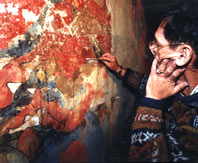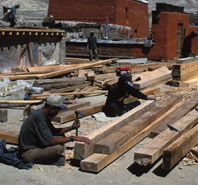|
In order repair the paintings, head conservator Rodolfo Lujan and
his team began a painstaking process. First, they cleaned the
paintings with a special solvent. Made of ethyl alcohol and powdered
ammonium bicarbonate, the solvent dissolves dirt and grease. The
restorers were careful to dab the cleaning solution onto the
paintings through a thin barrier of tissue paper, a method that
ensures only the painting's surface dirt—and not its pigments,
made of semiprecious stone—comes off. (The same method was
used to clean Michelangelo's ceiling frescoes in the Sistine
Chapel.)
Once the paintings were clean, the team began the next step:
securing loose pieces of plaster to the monastery's mud walls. Using
a plaster made from mud, they filled up the gap between the detached
painted plaster suface and the wall behind. They then used a
syringe-like applicator to inject a powerful adhesive behind the
plaster, thus securing the painted plaster layers to the newly
thickened wall.
The final step in restoration involved touching up areas of the
paintings where color was missing due to extreme damage. To preserve
the integrity of the original paintings, Lujan's team used washable
watercolor paints in crosshatched strokes to complete both tiny and
large sections of the paintings. This way, future conservators could
readily distinguish new sections from original and easily remove
them if necessary. Lujan and his crew left other paintings restored
but not touched up.
The ongoing restoration of the paintings in Thubchen, along with the
structural renovations to the monastery's roof and beams, should
help ensure that these treasures will remain intact for another 500
years.


|

|
Head conservator Rodolfo Lujan works on one of
Thubchen's wall paintings.
|
|

|
Repairs to Thubchen's roof and beams will help protect
the newly restored paintings inside from future damage.
|
|
|

